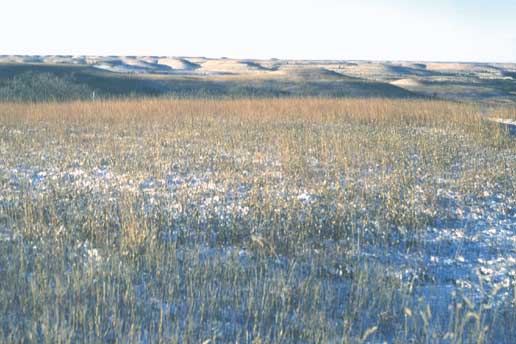A Place to Visit
Konza Prairie
![]()
Riley County,
Kansas

Native tallgrass prairie is a trademark of much of the Flint Hills, thanks to the region’s geology. Alternating layers of cherty limestone and shale form steep-sloped hills that are capped by the harder limestones. As the limestones are broken down by erosion, the even harder chert (or flint) accumulates at the surface. The combination of thin, rocky soils and steep slopes has precluded cultivation and promoted grazing and preservation of the native vegetation. Konza Prairie is a perfect example of tallgrass prairie that has retained its native characteristics. Konza Prairie Research Natural Area, containing 8,616 acres, is owned by The Nature Conservancy and managed by the Kansas State University Division of Biology for research on native prairie ecosystems. Two areas have been established for public use. A scenic overlook (pictured above) is five miles north of Interstate 70 (exit 313) on Kansas Highway 177. Three public hiking trails, open from dawn to dusk, are located near the main entrance to Konza Prairie on McDowell Creek Road. In addition to flint, invertebrate fossils, native grasses, and wildflowers, hikers can see deer, coyotes, turkeys, bats, or other wildlife. From Interstate 70 (exit 307), take McDowell Creek Road northeast five miles (from Manhattan, McDowell Creek Road heads southwest from Kansas Highway 177 just south of the Kansas River; drive 6.3 miles to the main entrance). A sign marks the main entrance on the east side of the road. Take the gravel road about one-half mile to the parking area. The trails begin at the parking area, where trail guides are available.

Kansas Geological Survey
1930 Constant Avenue, Campus West
Lawrence, Kansas
66047-3726
(785) 864-3965
-
Tom Collinson, Chair, Pittsburg
-
Robert Crangle, Lincoln
-
Dyan Jones, Prairie Village
-
Sheila Leiker-Page, Victoria
-
Jeffrey Mason, Goodland
-
Dennis McKinney, Greensburg
-
Stephen Morris, Hugoton
-
Larry J. Richardson, Wichita
-
John K. Strickler, Manhattan
-
William W. Hambleton, Emeritus Member, Lawrence
-
A. Scott Ritchie, KU Geology Assoc. Rep., Wichita
Director: Lee Allison
The mission of the Kansas Geological Survey, operated by the University of Kansas in connection with its research and service program, is to conduct geological studies and research and to collect, correlate, preserve, and disseminate information leading to a better understanding of the geology of Kansas, with special emphasis on natural resources of economic value, water quality and quantity, and geologic hazards.
The Geology Extension program furthers the mission of the KGS by developing materials, projects, and services that communicate information about the geology of Kansas, the state's earth resources, and the products of the Kansas Geological Survey to the people of the state
Online February 10, 2003
Comments to: lbrosius@kgs.ku.edu
Kansas Geological Survey
URL:http://www.Publications/GeoRecord/2000/vol6.1/Page4.html